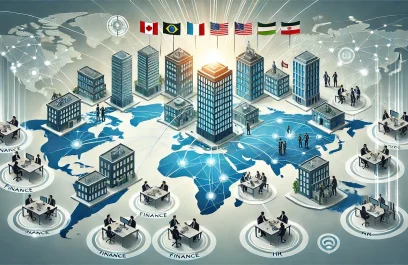Global Shared Service
Efficiency Through Collaboration
Forward-thinking businesses understand that the path towards exponential growth can only be traversed through optimal resource utilization and operational efficiency. By centralizing the delivery of different operational functionalities for their multiple global offices, the Global Shared Services model makes this achievable and seamless.
Global Shared Services (GSS), also known as Global Business Services (GBS), Shared Services, and Shared Service Centers (SSC), is a centralized framework that unifies an organization’s back-office and front-office operations into a single cohesive unit.
Maximizing Efficiency with Global Shared Services
By centralizing integral functions such as accounting, HR, and IT into a unified unit, the GSS model eliminates redundancy, boosts efficiency, and optimizes value creation. A unified approach to service delivery results in streamlined processes, improved service quality, and better overall business growth and performance. Centralized decision-making enhances business agility through flexible resource allocation and swift market responsiveness.
Trusted by the Best

















Key Insights
Key Considerations
How does the Global Shared Services model streamline operations and improve resource allocation?
The GSS model operates by centralizing and standardizing various business functions like finance and accounting, IT, HR and procurement, allowing companies to operate with fewer resources and lower operating costs. By leveraging advanced technologies like automating repetitive tasks, the GSS model improves efficiency and accuracy, enabling business units to focus on core activities. Centralized data management enhances decision-making, while consistent service levels ensure reliable quality. The GSS model optimizes talent deployment and reduces operational costs, creating a scalable, agile, and efficient operational model that supports organizational growth and responsiveness to market demands.
How is the Global Shared Services model different from traditional service delivery models?
The GSS model represents an evolution beyond the traditional service models, providing a single-point solution to business services management and delivery. Going beyond consolidating tasks or minimizing costs, Global Shared Service centers prioritize exceptional service quality, optimized decision-making, and data-driven innovation. Through the centralization of services and the integration of advanced technologies, the GSS model enables companies to achieve greater efficiency and agility. A standardized and centralized system makes it easier for companies to scale their operations without having to constantly rework processes for new regions or departments.
How can companies use Global Shared Services for digital transformation?
Global Shared Services capitalize on advanced technology, automation tools and a skilled workforce to power service delivery at an organization-wide level. By leveraging Robotic Process Automation (RPA), Global Shared Service centers can automate repetitive, high-volume tasks like payroll processing, invoice management, and reporting, reducing manual effort and error rates. A large number of companies use AI-powered analytics within their GSS to glean predictive insights and automate customer service responses, or optimize supply chains. With access to information from various functions, GSS centers can use centralized analytics platforms to identify trends, track performance metrics, and enable data-driven decisions, enhancing forecasting and planning across various departments.
Which industries see the highest ROI from the GSS model?
Industries with the highest ROI from the GSS model include financial services, healthcare, pharmaceuticals, technology, telecommunications, consumer goods, manufacturing, and energy. GSS enables these industries to centralize key functions such as finance, HR, procurement, IT, and compliance, leading to significant cost savings, improved efficiency, and enhanced regulatory adherence. By streamlining operations and leveraging data-driven insights, GSS helps these sectors optimize supply chains, scale quickly, and improve decision-making, resulting in higher profitability and operational agility.
How is the GSS model different from outsourcing?
The GSS model centralizes functions such as HR, IT, Legal, and accounting within the different offices of an organization to enhance efficiency, reduce costs, and standardize processes. Unlike outsourcing, where tasks are contracted out to third-party providers, the GSS model maintains control and oversight internally, fostering alignment with company goals and culture. This internal approach enables more flexible resource allocation and faster adaptation to market changes. A key advantage of a GSS over outsourcing is the direct access and control it offers. As GSS units are fully owned by the parent company, they ensure better control over operations, alignment with corporate strategies, and consistent levels of service delivery.
What are the best locations for setting up a GSS?
Identifying the location for setting up the GSS is driven by a variety of strategic considerations, like the availability of skilled talent, a robust digital infrastructure, and a favorable regulatory environment. As of 2024, the top 5 locations for setting up GSSs are India, Poland, UAE, Vietnam, and Mexico. Apart from these, Argentina, Romania, Brazil, and the Czech Republic are also highly preferred destinations. India’s vast talent pool, robust technology ecosystem, and thriving startup culture make it the prime GCC destination to drive business growth and innovation.
What are the key performance indicators (KPIs) for a successful Global Shared Service Center?
Today’s Global Shared Service centers operate as strategic extensions of corporate headquarters, driving overall business outcomes. Key performance indicators (KPIs) for a successful GSS include:
- Adherence to Service Level Agreements (SLAs), ensuring timely and quality service delivery.
- Cost reduction is a critical metric, with GSSCs aiming to lower operational expenses through centralization and process optimization.
- Eliminating data silos is vital, measured by the integration of cross-functional data and seamless information sharing.
- Finally, increased operational efficiency, tracked through streamlined workflows, reduced error rates, and faster turnaround times, reflects the overall effectiveness of the GSS center
Why should a company consider setting up a Global Shared Service unit?
GSS units streamline and optimize the delivery of services across multiple functionalities and locations of the organization, effectively eliminating redundancies and data silos, thus enabling better decision-making and resource allocation. They also ensure consistent service quality across all locations of the organization, making it easier for companies to manage global operations. By optimizing resource utilization and maintaining control internally, a GSS unit acts as a strategic partner, contributing significantly to the organization’s overall success.
What are the typical timelines and steps involved in setting up a GSS unit?
Generally, setting up a GSS unit can take 6-8 months from the initial date, depending on various factors such as location selection, regulatory approvals, infrastructure setup, talent acquisition, and technology deployment. However, with ANSR’s team of in-house experts, the end-to-end setup of your GSS unit is completed within 4-6 weeks.
What support services are available to assist in the setup and management of a GSS unit?
At ANSR, our team provides an end-to-end solution for GSS setup~
- Step 1- GSS Model and Design: Intake, talent intelligence, and strategic consulting for every aspect of setting up the unit, ultimately culminating into the GSS Playbook.
- Step 2 – GSS Solutions and Setup: Setting up and registering a legal entity, talent acquisition, workspace design & setup, and systems configuration to streamline your global operations.
- Step 3 – GSS Operations: End-to-end talent lifecycle management, building the EVP(employee value proposition) and employer branding, onsite IT support, workspace management and finance, tax and regulatory compliance.
Explore ANSR’s Offerings / Discover our Full Range of Services
What are the costs associated with establishing and maintaining a Global Shared Service unit?
Establishing a Global Shared Service unit entails initial setup costs such as acquiring facilities, developing infrastructure, and recruiting talent. Maintenance costs include salaries, technology upgrades, and operational expenses. These costs can vary significantly depending on location and scale. However, the long-term advantages, including cost savings and enhanced operational efficiencies, typically justify the initial investment.
ANSR’s team of experts works in close collaboration with your internal teams to align our offerings with your strategic objectives. From conceptualizing and defining the value proposition of your Global Shared Service Center to its establishment and operational launch, we ensure seamless integration with your business goals.
Deep Dive

Drawing Parallels: Principles of Distributed Agile Teams and Global Capability Centers (GCCs)
Drawing parallels between distributed agile teams and GCCs, we found several similarities between them. They have both have continued to perform well during the pandemic but what does the next normal look like for them, especially when organizations are focused on building a people-centric culture?

Navigating Global Markets: How Captive Centers Facilitate International Expansion
With the rise of Captive Centers, also known as Global Capability Centers (GCCs), companies have found a powerful solution to facilitate international expansion. Let’s explore how global captive centers serve as strategic enablers for businesses seeking to thrive in diverse markets and reach new horizons.

GCCs Then and Now: Tracing the Evolution from IT Support to Tech Innovation Hubs
Once regarded as a support function, technology has evolved rapidly in recent years and is now integral to the core of every business as companies embrace digital innovation to meet new consumer expectations.
Case Studies
- India GCC makes up 40% headcount outside HQs
- Powering 12 critical business functions
- Ramped up from 50-member team to 4300
- Powering core business functions & innovation
- More than 200 countries and territories to fast
- Visa operates over 14,500 financial institutions
- Company boasting over 32,000 outlets worldwide
- Journey to establish a Center of Innovation in India







